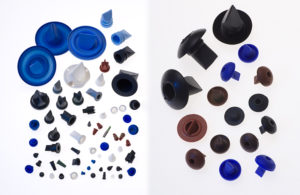An elastomeric check valve ensures that regardless of any back pressures in the system, there isn’t a reverse flow causing cross-contamination.
Tara Bryce, Vernay

Common elastomeric check valves include duckbill valves (left) and combination valves (right). [Image courtesy of Vernay]
The complexity of the elastomeric check valve in your medical device requires considering this important function in the early stages of design and development. Postponing an in-depth consultation with your check valve supplier can cause delays and expensive redesigns.
As today’s medical device market becomes increasingly complex and technology takes huge leaps forward, the check valve remains an integral part of the performance and reliability of each device. An elastomeric check valve ensures that regardless of any back pressures in the system, the drug, blood, saline or other fluid/material doesn’t encounter a reverse flow causing cross-contamination.
There are multiple types of elastomeric check valves designs and multiple material choices available in the market. However, finding a standard off–the–shelf part isn’t always an option when looking for a check valve for a new device. For custom medical devices, you need to partner with a supplier that has (1) geometric design experience, (2) material formulation expertise, and (3) functional performance based on prototyping capabilities.
Some of the most common elastomeric check valves used in medical devices are duckbill, umbrella, disk, v-ball, combination and bi-directional valves.
These valves come in different shapes, sizes, thicknesses and materials. All of these variables play together to allow the valve to perform at its optimal level. The precise size, thickness, composition, and the valve’s seat within the device determine the valve’s performance. For example, a duckbill is a “normally open” valve and generally allows for low cracking pressure to open and provide a non-tortuous path for fluid to follow. On its own, it will need a certain back pressure to close firmly and completely, and even then, there is always a risk of backflow leakage. However, with slight changes to the geometry of the duckbill and the seat that it rests in, a duckbill can be made to become “normally closed.” Achieving a “normally closed” duckbill requires design knowledge and flow control know-how. Umbrella valves are “normally closed” but only work well when matched to a sealing surface.
For materials, the obvious concerns are the biocompatibility of the elastomer, the chemical reaction of your fluid to that elastomer, and leachables and extractables. However, there are other factors besides compatibility. Concepts like compression set, tackiness, durometer, elongation and more all come into play in the design of the compound used for your check valve.
Primary materials used in medical devices range from silicones to polyisoprenes to fluorinated polymers to EPDM’s. Each of these materials matches well to certain processes for molding and finishing. It’s important to consider the combination of all these factors as well as custom formulations designed for your drug or custom performance needs.
In every project, simulation techniques such as mold flow, FEA (finite element analysis) and CFD (computational fluid dynamics) are essential to predicting the proper design and construction of your check valve. Functional prototyping is just as important, though often disregarded. Prototype samples of the check valve with the precise geometry and molded with the required (custom) formulation, not with a generic material, are pivotal. Testing at the beginning of a project with functional check valves saves time, money and effort. Going into clinical trials with a “first time seen” functional check valve can be disastrous to a project. You need to have functional prototype check valves at the beginning of the project, where you can easily and affordably make adjustments in geometry and/or material.
You can make all the plastic parts in the world fit together nicely, but if the check valve doesn’t work, then the device fails, to no one’s benefit. Therefore, you should consider the check valve design process as critical to the function of your device. It is the “make it or break it” part of the device most of the time.
Tara Bryce is global medical business unit manager at Vernay. She has been in the medical device / pharmaceutical primary packing industry for over 10 years, working with startups, large pharma and global medical device manufacturers as a supplier and CMO in business development, sales and marketing.
The opinions expressed in this blog post are the author’s only and do not necessarily reflect those of MedicalDesignandOutsourcing.com or its employees.